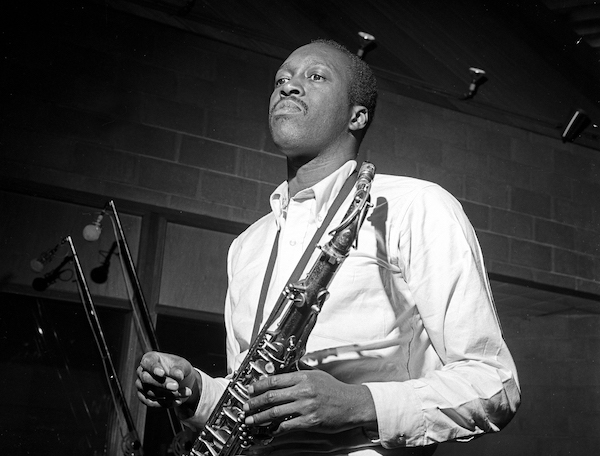Oct 28, 2025 10:47 AM
In Memoriam: Jack DeJohnette, 1942–2025
Jack DeJohnette, a bold and resourceful drummer and NEA Jazz Master who forged a unique vocabulary on the kit over his…

Hank Mobley (1930–1986)
(Photo: Francis Wolff ©Mosaic Images LLC/mosaicrecordsimages.com)“Hank was a joy to be around, he never created problems, never got loud and boisterous,” Mabern said of the sessions that produced Dippin’, the only album the two musicians made together. “He was pure in heart. Those are the things that made the date easy for us, but he was no pushover: He knew what he wanted; you couldn’t jive him.”
Mobley did not always adhere to a standard format, as illustrated by his 1966 octet recording, A Slice Of The Top. His sharp timing and command of all registers remained steadfast while he created long choruses for a distinctive brass section that included euphonium and tuba. While Duke Pearson was nominally in charge of the arrangements, they flowed from Mobley’s instructions. The tracks range from a waltz in 6/8 time (“Cute ’N Pretty”) to the title track’s multidirectional groove.
The groundbreaking LP sat unreleased until 1979, about six years after Mobley expressed frustration at the amount of his material sitting in the Blue Note vault. His exasperation seems understandable, and the new Mosaic collection includes tracks from five compelling albums that were recorded in the 1960s but not released until the late ’70s and mid-’80s. Still, as Mosaic producer Michael Cuscuna pointed out, Mobley and his contemporaries—including Morgan, Jimmy Smith and Grant Green—created more tracks than any label could have been expected to issue around the time they were recorded.
During Mobley’s last years in the studio, his work also included covers of r&b hits, like the Four Tops’ “Reach Out I’ll Be There,” as well as original compositions that emphasized immediately attractive melodies with repeating motifs, such as “The Flip.” In some ways, these tracks show that after 20 years of invention, he never lost his feel for r&b.
Bassist Mickey Bass, who played on the saxophonist’s 1970 Blue Note album, Thinking Of Home, said Mobley’s compositional skills remained honed, regardless of the distractions or hardships he faced. “With both Hank and Lee Morgan, their genius was so great that in spite of their addictions, they would write out most of the tunes for the record date in the cab on the way to rehearsal,” Bass recalled. “That genius was unheard of at that particular time.”
In 1972, Mobley recorded his last album, Breakthrough!, a collaboration with pianist Cedar Walton. (It was released on the Cobblestone label and later reissued by Muse).
Mobley continued his peripatetic lifestyle in the years that followed, but with the possibility of new music always out there. At the time of his 1973 DownBeat interview, Chicago was his home and he had started working with pianist Muhal Richard Abrams. No recording of the two is known to exist, which is a shame. Mobley’s final years remain mysterious, but he was known to have suffered from lung cancer and bouts of homelessness. It’s conceivable that he saw how his advanced ideas for composing and arranging on A Slice Of The Top became part of the lexicon for some of the groups coming out of Abrams’ Association for the Advancement of Creative Musicians.
As Bob Blumenthal writes in the liner notes to Blue Note Sessions, Mobley did achieve a moment of acclaim shortly before his death. When Blue Note experienced its rebirth in 1985, the label invited him to participate in a relaunch concert at New York’s Town Hall. Mobley appeared at the event, but he chose to speak to the audience, rather than perform. In some regard, he didn’t have to, as everyone present seemed to acknowledge that the label, and jazz itself, had thrived because of Mobley’s contributions. DB

Jack DeJohnette boasted a musical resume that was as long as it was fearsome.
Oct 28, 2025 10:47 AM
Jack DeJohnette, a bold and resourceful drummer and NEA Jazz Master who forged a unique vocabulary on the kit over his…

D’Angelo achieved commercial and critical success experimenting with a fusion of jazz, funk, soul, R&B and hip-hop.
Oct 14, 2025 1:47 PM
D’Angelo, a Grammy-winning R&B and neo-soul singer, guitarist and pianist who exerted a profound influence on 21st…

Kandace Springs channeled Shirley Horn’s deliberate phrasing and sublime self-accompaniment during her set at this year’s Pittsburgh International Jazz Festival.
Sep 30, 2025 12:28 PM
Janis Burley, the Pittsburgh International Jazz Festival’s founder and artistic director, did not, as might be…

Jim McNeely’s singular body of work had a profound and lasting influence on many of today’s top jazz composers in the U.S. and in Europe.
Oct 7, 2025 3:40 PM
Pianist Jim McNeely, one of the most distinguished large ensemble jazz composers of his generation, died Sept. 26 at…

Drummond was cherished by generations of mainstream jazz listeners and bandleaders for his authoritative tonal presence, a defining quality of his style most apparent when he played his instrument unamplified.
Nov 4, 2025 11:39 AM
Ray Drummond, a first-call bassist who appeared on hundreds of albums as a sideman for some of the top names in jazz…